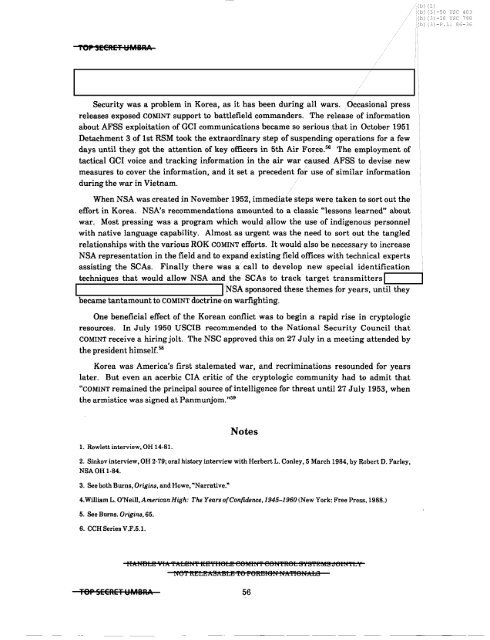American Cryptology during the Cold War - The Black Vault
American Cryptology during the Cold War - The Black Vault
American Cryptology during the Cold War - The Black Vault
You also want an ePaper? Increase the reach of your titles
YUMPU automatically turns print PDFs into web optimized ePapers that Google loves.
Ib) (1)<br />
Ib) (3) -50 USC 403<br />
Ib) (3) -18 USC 798<br />
Ib) (3) -P.L. 86-36<br />
TOfl SeERET l:IMBAA<br />
Security was a problem in Korea, as it has been <strong>during</strong> all wars. Occasional press<br />
releases exposed COMINT support to battlefield commanders. <strong>The</strong> release of information<br />
about AFSS exploitation of GCI communications became so serious.that in October 1951<br />
Detachment 3 of 1st RSM took <strong>the</strong> extraordinary step of suspending opera.tions for a few<br />
days until <strong>the</strong>y got <strong>the</strong> attention of key officers in 5th Air Force. 56 <strong>The</strong> employment of<br />
tactical GCI voice and tracking information in <strong>the</strong> air war c.aused AFSS to devise new<br />
measures to cover <strong>the</strong> information, and it set a precedent for use of similar information<br />
<strong>during</strong> <strong>the</strong> war in Vietnam.<br />
When NSA was created in November 1952, immedia.te steps were taken to sort out <strong>the</strong><br />
effort in Korea. NSA's recommendations amounted/to a classic "lessons learned" about<br />
war. Most pressing was a program which would allow <strong>the</strong> use of indigenous personnel<br />
with native language capability. Almost as urgent was <strong>the</strong> need to sort out <strong>the</strong> tangled<br />
relationships with <strong>the</strong> various ROK COMINT efforts. It would also be necessary to increase<br />
NSA representation in <strong>the</strong> field and to expand existing field offices with technical experts<br />
assisting <strong>the</strong> SCAs. Finally <strong>the</strong>re was a call to develop new special identification<br />
techniques that would allow NSA and.<strong>the</strong> SCAs to track target transmittersI<br />
INSA sponsored <strong>the</strong>se <strong>the</strong>mes for years, unt-il-t~h-ey-""<br />
became tantamount to COMINT doctrine on warfighting.<br />
I<br />
One beneficial effect of <strong>the</strong> Korean conflict was to begin a rapid rise in cryptologic<br />
resources. In July 1950 USCIB recommended to <strong>the</strong> National Security Council that<br />
COMINT receive a hiringjolt. <strong>The</strong> NSC approved this on 27 July in a meeting attended by<br />
<strong>the</strong> president himself.58<br />
Korea was America's first stalemated war, and recriminations resounded for years<br />
later. But even an acerbic CIA critic of <strong>the</strong> cryptologic community had to admit that<br />
"COMINT remained <strong>the</strong> principal source ofintelligence for threat until 27 July 1953, when<br />
<strong>the</strong> armistice was signed at Panmunjom."59<br />
1. Rowlett interview, OH 14-81.<br />
Notes<br />
2. Sinkov interview, OH 2-79; oral history interview with Herbert L. Conley, 5 March 1984, by Robert D. Farley,<br />
NSAOH 1-84.<br />
3. See both Burns. Origins, and Howe, "Narrative."<br />
4.William L. O'Neill, <strong>American</strong>High: <strong>The</strong> Years ofConfidence. 1945-1960 (New York: Free Press, 1988.)<br />
5. See Burns. Origins, 65.<br />
6. CCH Series V.F.5.1.<br />
IhldiBbl!J VIA 'f1tLl!Jfff f(I!JYII6LI!J e6MIN'f e6fi'fR:6b S'{S'fI!JMS J6IWft:: i<br />
H'6'f KI!JLI!JASABLI!J 'f6 f'6R:I!JI8fi ftA'fI8fiALS<br />
Tap SECRET l:IMBRA 56<br />
------_._---- ---
















